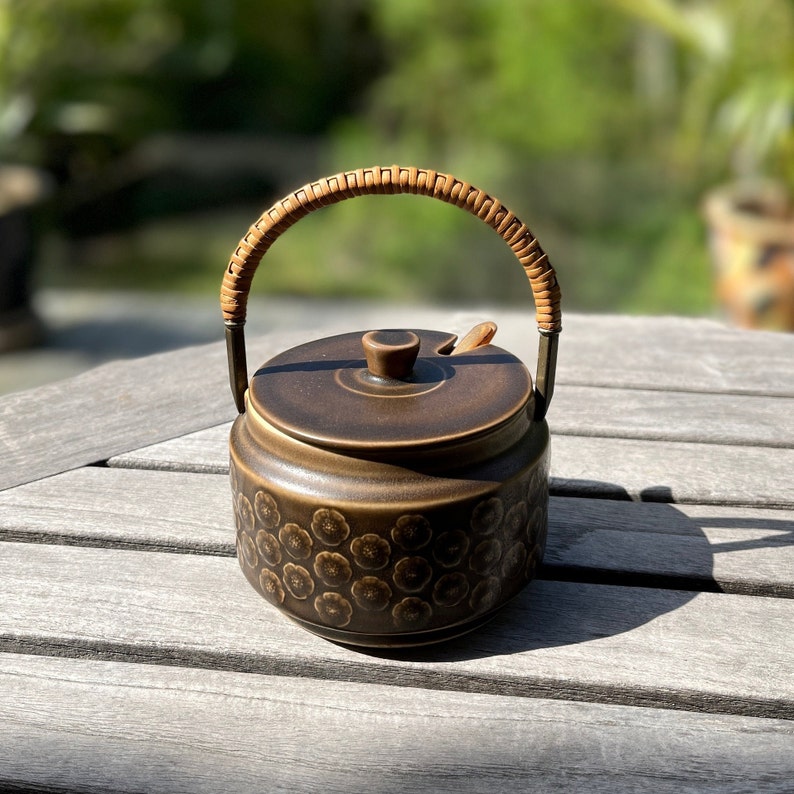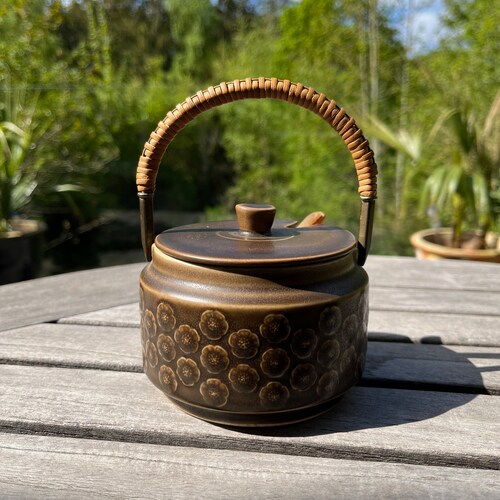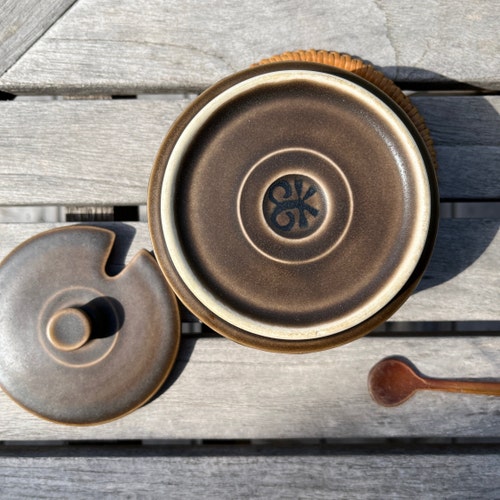RARE! Marmelade 2024 jar by JENS QUISTGAARD for Kronjyden Nissen / Umbra series / Danish modern / Scandinavian design / Mid century modern
Rare piece by Jens Harald Quistgaard.
This marmelade jar is produced in the 1960's at Kronjyden Nissen in Denmark.
The design is called “Umbra” and it is on of JHQ's more rare series.
Condition is near mint - The bast looks almost new and no cracks, chips or repairs on the ceramic part.
Meassures:
Height: 8cm
Diameter: 10cm
Weight ≈ 400g + wrapping
Please contact us if you have any questions, or if you have any problems with shipping prices - they can sometimes be adjusted!
Combined shipping is allways more economical, because shipping fees are calculated by weight. The pricelevel change at the following weights:
L1: 0kg - 2kg
L2: 2kg - 5 kg
L3: 5kg - 10kg
All packages are insured and with track and trace number.
Deep dive Jens Harald Quistgaard:
Jens Quistgaard grew up in an artistic home in Copenhagen and already as a boy, demonstrated unusual artistic talents. The work with handicrafts began in his mothers kitchen, where he made himself a little workshop with vice and anvil. Here he produced jewellery, hunting knives, bags and ceramics. When he was young Jens Quistgaard would often be found at the village smiths, carpenters or joiners, and it was here he acquired the craftsmanship which he later used to produce models in wood, metal, ceramic and glass. He was trained as a sculptor by his father, Harald Quistgaard (1887-1979), and was later educated as a drawer and silversmith at the technical school in Copenhagen. During the occupation of Denmark he was active in the Resistance movement.
Quistgaard started his career drawing portraits. He also produced jewellery, hunting knives, ceramic works, glass and graphic design in the form of monograms, town arms and the like. At the end of the 1940s his production also included cutlery in silver and steel for different companies, amongst others the silvery cutlery set Champagne (1947 for O.V. Mogensen) and kitchen utensils in steel for Raadvad [da], including the little shark fin can opener from 1950. His breakthrough as an industrial designer came in 1953–54, where he fashioned the cutlery set Fjord, the first cutlery set that combined stainless steel with handles of teak.
Around the same time he designed a saucepan in cast iron for De Forenede Jernstoeberier A/S (United Iron Foundries). The pan was marketed under the name Anker-Line and was awarded the gold medal at the Triennale in Milan in 1954. In the same year, Quistgaard also received the Lunning Prize. 1954 was also the year American businessman Ted Nierenberg visited Europe, on the lookout for talented design which could be launched in the USA. After having seen the cutlery set Fjord at the Danish Museum of Art and Design in Copenhagen, he sought out the designer, and their meeting led to the foundation of the American company Dansk Designs with Quistgaard as chief designer.
Already towards the end of 1954, Fjord was introduced in New York, followed the year after by the colourful saucepan range Kobenstyle. Quistgaards designs were a big success from the beginning in the US and were quickly followed by a series of tableware and kitchenware designs: cutlery in silver and handcrafted steel; jugs and saucepans in steel, copper and cast iron; crockery in stoneware; glass; trays, bowls, pepper mills and other objects in staved teak and exotic wood sorts, as well as candlesticks in brass, silver and cast iron.
Quistgaard was hugely productive and for Danish Designs alone fashioned more than 4000 products.[5] It is a production which spans a large range of materials and utility items, and which is created from a philosophy that utility items for the kitchen and the table should function together harmoniously. To set the table and arrange with Quistgaard's designs became from the end of the 1950s and during the 1960s identical with "modern living" 2024 and Scandinavian style.[6] Where clean lines, sculptural form and natural materials went hand in hand.




